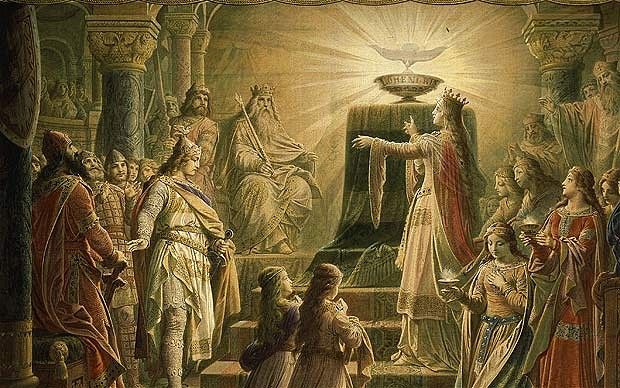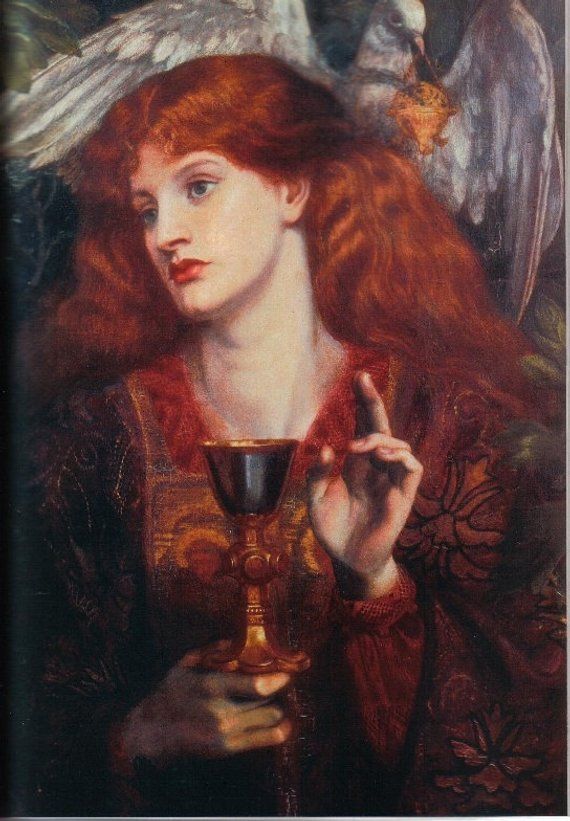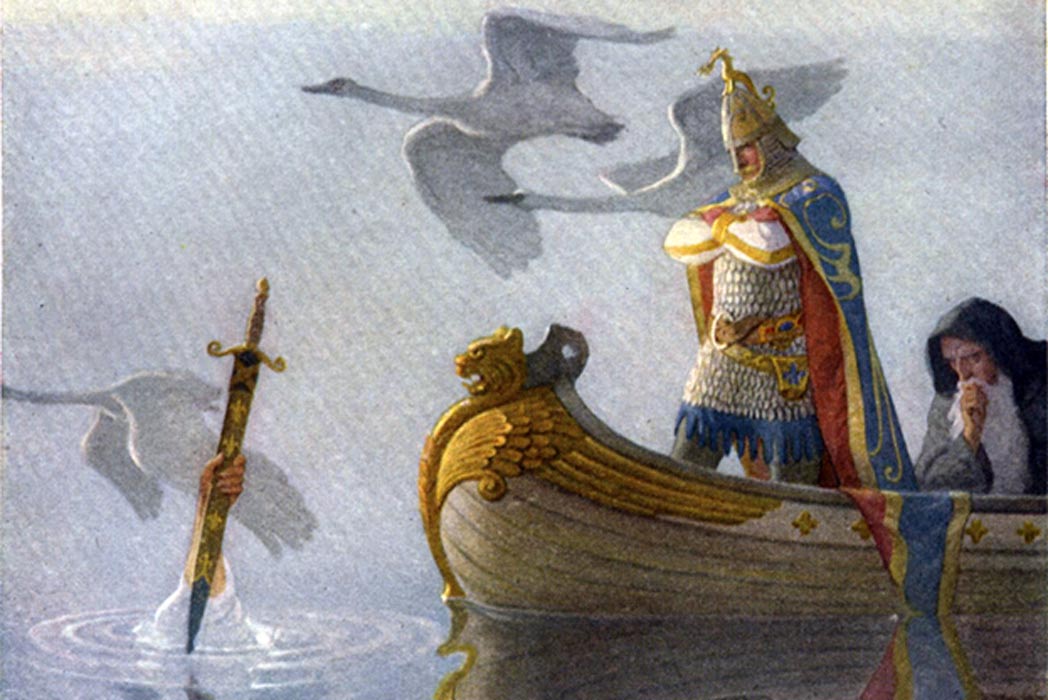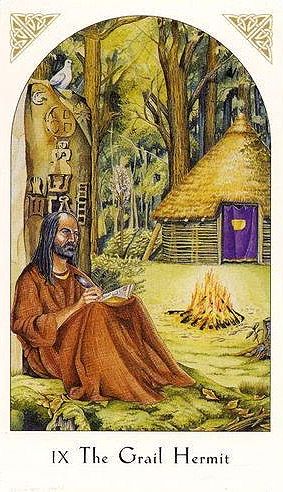
I have written the story of the myth, including important figures as headlines. Below the story, I have written the meaning, including the figures and their symbolic representations.
Parsifal
Parsifal is a humble, naive young man living with his mother in the woods. So unimportant that he doesn’t have a name. While out playing one day, Parsifal saw 5 Knights. Returning to his house, he told his mother he was leaving to join the Knights. His mother was distraught and told the boy about his father and brothers dying as Knights, but this didn’t deter Parsifal. He left his mother, and she left two parting words of advice –
1) Respect fair damsels
2) Don’t ask too many questions.
His mother gave him a homespun tunic to wear for home comfort.
He saw a tent on his travels, something he had never seen before, having lived with his mother in the forest all his life. He thought about a myth his mother told him about a divine cathedral where he would be nourished his whole life.
He entered the tent to find a fair maiden and a banquet and sat down to eat. However, the maiden was waiting for her Knight. He left the tent after remembering his mother’s instruction to respect fair damsels. But not before taking a talisman from her to take with him as inspiration for the rest of his life.
Parsifal asked everyone he met how he could become a Knight and told them the five knights’ story while in the forest. They all told him to go to King Arthur’s court, where he would be Knighted if he were strong and brave enough.
Upon arriving at King Arthur’s court, Parsifal got mocked and laughed at. With persistence, Parsifal continued asking to be a knight, which brought the attention of King Arthur. King Arthur told Parsifal that a man must learn many things before becoming a Knight.

Laughing Damsel
There was a myth at King Arthur’s castle that when the best Knight in the world appeared, the Damsel who hadn’t smiled for six years would burst into laughter. This came true. The Damsel burst into laughter when she saw Parsifal and his homespun tunic from his mother. The court became very impressed, and King Arthur immediately knighted the young man.
Red Knight
When leaving the castle, Parsifal meets the Red Knight, who is bold and powerful. He asks the red Knight if he can have his armour, to which the Knight replies, ‘you may have it if you can get it’. After a battle, Parsifal killed the red Knight with a dagger to the eye. From this battle onwards, Parsifal saved the lives of all the men from every battle, inviting them to visit King Arthur’s castle and swear allegiance.
The Young Man didn’t know how to wear the armour as he had never had such garments before. He was encouraged by a page to take off his homespun garment, but he refused and wore the armour on top of it and rode away.
Gouramond
The next figure he met was Gouramond, the archetypal Godfather. Gouramond taught him information as an initiation into manhood. He gave Parsifal two pieces of advice: ‘ never seduce or be seduced by a fair maiden” and ‘you must search for the Grail castle with all his might’. And he also told Parsifal to ask, ‘to whom does the Grail serve?’
He then set off to find his mother. He discovered she had died of a broken heart when he left home, making Parsifal feel incredibly guilty.
Blanche Fleur
He encountered a fair damsel named Blanche Fleur (white flower) on his search. Her castle was under siege, and she asked Parsifal to save her kingdom. He first duelled with the second in command and then the commander – ‘duelling heroically with him’. He duelled with both of them but refused to kill them. He sent them to King Arthur’s court to pledge their allegiance.
Parsifal returned to Blanche Fleur’s castle after raising the siege. They slept together. They slept together in the most intimate embrace – head to head, shoulder to shoulder, hip to hip, knee to knee, toe to toe. Nevertheless, the embrace was chaste and worthy of the Young Man’s vow that he never seduce or be seduced by a fair maiden – The wise words of Gouramond.
The Young Man travelled all day and, at nightfall, asked someone if there was a lodge nearby where he might spend the night. He was told there was no habitation within thirty miles. Soon he found a man in a boat fishing on a lake; it was the Fisher King. He asked if there was any place to stay the night, to which the Fisher King replied – “Just go down the road a little way, turn left, across the drawbridge.”
Grail Castle
Parsifal followed these directions and found the castle. The drawbridge slammed shut as he reached the other side, clipping the back hooves of his horse.
Four youths took Parsifal’s horse, bathed him and gave him fresh clothing. They then led him to The Fisher King, the master of the castle and the rest of the court. This consisted of 400 knights and ladies. A grand ceremony took place, including the nightly rituals. The Fisher King lay groaning while three maidens entered. The first carried the lance that pierced Christ’s side at the crucifixion, the second had the metal plate from Christ’s Last Supper, and the third held the Holy Grail.

Fisher King
The court held a banquet. Everyone, except the Fisher King, drank from the Holy Grail, and each was granted their greatest wish. The Fisher King’s niece brought forth a sword which the King strapped to Parsifal’s waist. This sword would be the Young Man’s for the rest of his life. But, not remembering what Gouramond said to him, he forgot to ask, ‘Whom does the Grail serve?’.
The Fisher King was taken from the chamber in agony. Everyone dispersed, and the four youths took the Young Man to his chamber. The following day Parsifal found himself alone. He saddled his horse, and upon crossing the drawbridge, it snapped shut and hit his horse’s hooves. When the Young Man turned around, the castle was nowhere to be seen.
Tearful Maiden
Riding on, the Young Man came upon a tearful maiden holding her lover in her arms. Her lover was a knight killed by another knight in vengeance over something the Young Man did in his earlier naive adventures. When the Young Man told the maiden where he had been, she told him there was no habitation within thirty miles. Upon further conversation, she said, ‘Oh, you have been in the Grail castle’. The maiden asked the Young Man his name, and as the answer abruptly came to him, he exclaimed – “Parsifal”. (This was the first time that Parsifal was named in the original story)
Parsifal rode on again and found another weeping maiden, who also had suffered repercussions from Parsifal’s younger behaviour. This maiden informed Parsifal that his sword would break the first time he used it and that it could only be fixed by the one who forged it. Once mended, it would never break again.
Remember, Parsifal did not kill his enemies. The knights he conquered were sent back to Arthur’s court. He rescued many damsels, protected the poor and slew many dragons. King Arthur set out to find this great hero. Arthur vowed “not to sleep two nights in the same bed” until he found this fantastic Knight.
As Parsifal continued on his path, a falcon attacked three geese flying over his head. Three drops of blood fell on the snow next to Parsifal, and he fell into a lover’s trance. Parsifal could think of nothing but Blanche Fleur.
It was in this state that Arthur’s men found him.
Two knights tried to lead Parsifal back to Arthur, but he fought them off, breaking one of the knights’ arms. It was the man who had jeered at him when the sad maiden laughed in Arthur’s court. Parsifal had vowed to avenge her for that scorn, which was now complete. Gawain, a third knight, humbly asked Parsifal if he would return with them to Arthur’s court, to which he agreed. Upon arrival, Arthur set Parsifal at the court’s head. He declared a three-day festival, with a tournament in the Knight’s honour.
The Hideous Damsel
During the festival and at the height of the celebration, a Hideous Damsel appeared.
She rode in on a twisted mule that limped on all four feet. She recited to the court all of Parsifal’s past stupidities, the worst being his inability to ask the healing question in the Grail castle – ‘Whom does the Grail serve?’
Parsifal was left humbled and silent before the court that had moments before been praising him. From the Hideous Damsel, Parsifal learned that he had to find the Grail castle for a second time. He vowed not to sleep in the same bed twice until he found the castle again. Upon leaving, the Hideous Damsel reminded the court that the Grail’s search required chastity from the knights and limped off.
Parsifal then spent twenty years searching for the Grail castle. He grew bitter and disillusioned while further away from his beloved Blanche Fleur. Then he came upon a group of ragged pilgrims on the road. They told him, “What are you doing riding in full armour on this, the day of our Lord? It is Good Friday. Come with us to the Forest Hermit, say your confession and be shriven in preparation for Easter Sunday.” Parsifal went with the pilgrims to the old Hermit, and his dark mood was lifted.
The Hermit
Like with the Hideous Damsel, the Hermit shared all of Parsifal’s downfalls and said that his biggest failure was to ask the healing question, as mentioned by Gouramond. After this, the Hermit was gentle to Parsifal and instructed him to ‘go a short way, turn left and cross the drawbridge. The Grail Castle is always close at hand’.
(In the original story, the myth ends here.)
Parsifal followed the Hermit’s instruction and found the castle before with the same ceremony. The Fisher King was groaning on his litter. Finally, after twenty years of experience, Parsifal asked, ‘ Whom does the Grail serve?’. His question was not answered, for with this question, to ask well is also to answer. At Parsifal’s question, rejoicing burst forth in the Grail castle. The Fisher King was healed, and peace and happiness reigned over the land.
Myth Meaning
Fisher King
To understand the myth of Parsifal, we must understand the Fisher King of Arthurian legend. The Fisher King is the King of the castle. He is the keeper of the Holy Grail. The Fisher King is wounded, commonly with an injury in his thigh/groin. He is in unbearable pain, and the kingdom suffers as a result.
The Fisher King wound, in psychological terms, is a common condition for Western Man, where every young man, as Johnson notes. – “has naively blundered into something too big for him. He proceeds halfway through his masculine development and then drops it’s too hot. Often a certain bitterness arises because, like the Fisher King, he can neither live with the new consciousness he has touched nor can he entirely drop it.” However, this wound is crucial for the development of consciousness.
Through the intercession of Parsifal, its redemption leads to the complete integration of the Self – it leads to a life of self-awareness, contentment, passion and authenticity.

This myth is a sublime representation of the masculine psyche. Parsifal or ‘Young Man’ shows us that the ‘fool’, the naive and humble part of ourselves, is that which heals our Fisher King wound. The wound is a split in consciousness, a trauma in our early lives that makes us realise that life isn’t all happy sailing.
The name Parsifal means ‘Young Fool’. And this is an important symbol to understand.
Leaving mother and the move towards adulthood
Parsifal moves away from his mother after seeing 5 Knights while out playing symbolises adulthood’s progression (5 being the number of wholeness – quintessence).
Parsifal leaves home with his homespun garment signifying his emotional attachment to his mother, which must be shed as he matures. His mother offering the advice ‘don’t ask too many questions’, halts him from asking the all-important ‘whom does the Grail serve’ later in the story, signifying a holding back of consciousness in the young man.
Arthur’s Court and Laughing Damsel
When Parsifal finds his way to Arthurs’s court and the damsel bursts into laughter, this shows the feminine part of a man’s psyche, which has never been capable of happiness. If Parsifal, the fool, is awoken in a man, another feminine quality arises.
Red Knight
Parsifal then meets the bold and powerful Red Knight, who he kills with a dagger to the eye. The Red Knight is the shadow side of masculinity and is often seen in the outer world (in competition/sports) but sometimes in the inner world. If the Red Knight battle goes badly, the man may grow up with bullying and angry tendencies or be beaten by shyness.

Gouramond
Next, Parsifal meets Gouramond, who is a symbolic Godfather figure. The Human father energy usually dries up at a certain point in a man’s life. The Godfather figure shows the necessity for a masculine figure in a young man’s life as he grows away from his earthly father.
Gouramonds parting advice was – ‘don’t seduce or be seduced by fair maiden’ and ‘search for the Grail with all your might’. He also told Parsifal that he must ask, ‘whom does the Grail serve?’. Here, the fair maiden refers to the feminine qualities that reside within him, not necessarily a physical woman. And that he should not be pulled off his path in the search for the Grail.
In the literal sense, Gouramond advice about chastity makes little sense. His advice was to avoid living out the softness of femininity but know its value in the inner world.
The feminine side of a man is to connect him with his inner being’s depths and make a bridge to the deepest Self.
Mothers ‘Death’
After this, he went to find his mother to find she had died of a broken heart. This symbolises a young man’s need to leave his mother and develop into manhood, which is impossible without being disloyal to her in some aspect.
Blanche Fleur
Parsifal found Blanche Fleur (white flower) when trying to find his mother. This symbolises becoming aware of one’s highest motivation in life, stumbling across purpose and meaning when looking for something else. The archetype of Blanche Fleur is the fair lady and carrier of inspiration – the very core of heroic action. The mother’s search led to inspiration elsewhere. Jung called Blanche Fleur the Anima – the fountain of life in the heart of man.
Fellowship
Parsifal refuses to kill the second in command and, later, the commander. This is the beginning of adding fellowship to the knights of the round table. This myth shows the conscious manoeuvre of unconscious masculine energy into the centre of one’s personality.
Upon leaving Blanche Fleur, Parsifal travelled for a while, found a man in a boat fishing (The Fisher King), and asked if there was a place to spend the night. The man replied, “Just go down the road a little way, turn left, across the drawbridge.” Parsifal followed these directions and found the castle.
Grail Castle and The Fisher King
The drawbridge slammed shut as he reached the other side, clipping the back hooves of his horse. – This shows that it isn’t easy and takes courage to enter the Grail Castle.
‘The first carried the lance that pierced Christ’s side at the crucifixion, the second had the metal plate from Christ’s Last Supper, and the third held the Holy Grail itself.’ – Biblical references around Christ’s resurrection. This is symbolic of the individual’s resurrection from ego consciousness to God-consciousness.
We see some interesting references on his first visit to the Grail Castle. The Fisher King did not drink from The Holy Grail, referring that he (his wound) was not yet healed. Parsifal also forgot to ask the critical question, ‘Whom does the Grail serve?’ showing he was not ready to heal. There still lay a healing journey ahead.
Parsifal The Name
The Young Man’s significance in saying his name was ‘Parsifal’ when asked by a Maiden is that his name was not mentioned before this point. Parsifal had found his voice after his first Grail experience and had matured, becoming an individual.
Hideous Damsel
Parsifal then returned to Arthur’s court after being asked by a knight of the court. A hideous damsel appeared, which represents doubt and despair in the psyche. This doubt and despair remind Parsifal of all his stupidities and his biggest one – Not asking ‘whom does the Grail serve?’ at the Grail Castle. Parsifal was humbled, inspiring him to find the Grail Castle again. This shows how despair can enthusiastically drive a man to find himself.
The Hermit
After a long search, Parsifal meets the Hermit. The Hermit within is the archetype that needs to be drawn upon at middle age with a loss of meaning. The introverted nature has been storing energy during the energetic first half of life. The Hermit shares where the Grail Castle resides once again.
The original myth ends here, perhaps leaving the reader’s mind to finish the story.

Story Continued
Many of the continued stories say that Parsifal revisited the Grail Castle and asked, ‘ whom does the Grail serve?’. This healed the Fisher King’s wound, and the land turned peaceful – a logical conclusion.
‘Who does the grail serve’ represents the humility to shift life’s ambition from the ego to the Self /God. In the myth, the Fisher King is healed when he asks this.
The object of life is to serve the ‘Grail’ / God, which is humbling and removes the notion that we are living life for our happiness as an end goal.
Further Notes
Many myths put the cure to our ills in the fool. The Fisher King is healed when an innocent fool asks a specific question. The legend shows us that healing occurs in a naive part of oneself.
A man must accept that looking foolish and innocent can cure him. The inner fool is the only one who can touch his wound.
Recommended Watching/Reading :-